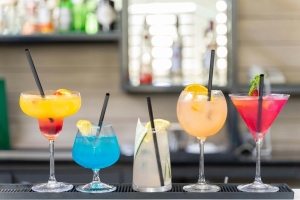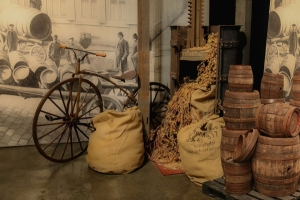cisa
Do Smart People Drink More Alcohol?
November 22, 2024Do Smart People Drink More Alcohol?
A new study analyzes the relationship between intelligence in adolescence, measured through IQ tests, and alcohol consumption in adulthood. People with higher IQs were found to have higher chances of drinking alcohol, but reported fewer episodes of abusive drinking.
A study published in 2024 (1) analyzed data from 6,300 American men and women who participated in a longitudinal project that began in 1957 (the "Wisconsin Longitudinal Study"), when the participants were around 18 years old. In 2004, 47 years after graduating from high school, the participants were asked about their alcohol consumption patterns. Specifically, they were asked how many alcoholic drinks they had consumed in the last 30 days and the frequency of binge drinking during that period.
Among various sociodemographic factors of these participants, the authors focused on education level and income, aiming to analyze whether these factors influenced the relationship between IQ in adolescence and alcohol consumption in adulthood.
The results were quite intriguing and sparked significant interest in the international media. The authors found that for each point increase in IQ, there was a 1.6% increase in reports of moderate or heavy alcohol consumption. However, among those who drank alcohol, having a higher IQ was associated with fewer reports of binge drinking. As noted by the authors, these results are influenced by many variables, and studies in other countries, such as Sweden and Denmark, have shown that higher IQ scores were associated with greater chances of abstinence (2).
One factor that influenced the relationship between IQ and alcohol consumption was the participants' income, as people with higher incomes were more likely to consume alcohol and, among those who drank, had a lower likelihood of engaging in abusive drinking. This income variable considered the participants' parents' income, given that the study began when they were at the end of their adolescence. The authors point out that this result suggests that children and teenagers who grow up in financially stable environments may have lower chances of abusive drinking in adulthood.
Although enlightening, this study has important limitations. In terms of the analyzed population, 99% of participants reported being white and born in 1939. The lack of diversity in the population makes it difficult to generalize these results. Therefore, since alcohol consumption is influenced by cultural variables, comparisons with Brazil should be made with caution. In general, this study highlights the importance of adolescence in the development of emotional and cognitive factors that can affect alcohol consumption in adulthood.
References:
1 - Druffner, N., Egan, D., Ramamurthy, S., O’Brien, J., Davis, A. F., Jack, J., ... & Brown, E. S. (2024). IQ in high school as a predictor of midlife alcohol drinking patterns. Alcohol and alcoholism, 59(4), agae035.
2 - Just-Østergaard E, Flensborg-Madsen T, Knop J, Sørensen HJ, Becker U, Mortensen EL. Intelligence in young adulthood and alcohol use disorders in a prospective cohort study of Danish men: the role of psychiatric disorders and parental psychiatric history. BMJ Open. 2019 Sep 4;9(9):e028997. doi: 10.1136/bmjopen-2019-028997. PMID: 31488478; PMCID: PMC6731796.
Brief Intervention to Reduce Risky Alcohol Consumption Has Proven Effective in the Elderly
November 22, 2024Brief Intervention to Reduce Risky Alcohol Consumption Has Proven Effective in the Elderly
A study conducted by researchers from the University of São Paulo (USP) in Ribeirão Preto observed a reduction in risky alcohol consumption among the elderly through a brief intervention protocol.
Harmful alcohol use among the elderly population leads to serious health complications and can even result in death. It is known that alcohol is the 7th largest risk factor for the total disease burden among individuals aged 50 to 69 years and the 10th for those over 70 years old (1).
According to the WHO (World Health Organization), brief intervention (BI) is one of the most cost-effective measures for treating harmful alcohol use (2). This therapeutic approach, widely used in the treatment of alcoholism, can also be applied to other mental health disorders. It consists of a set of practices aimed at identifying a real or potential problem related to alcohol use and motivating the person to take action about it.
Recently, researchers from the University of São Paulo (USP) in Ribeirão Preto assessed the effectiveness of brief intervention in reducing risky alcohol consumption among elderly individuals attended to in Primary Health Care (3). The study, conducted in the city of Ribeirão Preto, in Brazil, involved individuals aged 60 or older who reported alcohol use and scored between ≥ 5 and ≤ 19 on the AUDIT (Alcohol Use Disorders Identification Test) scale. Most participants were male, married, with a family income between 1 and 3 minimum wages, and some were retired, with 1 to 4 years of schooling.
According to the author of the research, the characteristics of BI for the elderly may include providing information about health behaviors and the risks associated with their level of consumption; interpreting screening results and discussing reasons for drinking and its potential consequences; understanding their support networks; and negotiating a plan for reducing alcohol consumption.
Sociodemographic results of the research showed that 46.5% (n=234) of participants had low-risk alcohol consumption; 44.5% (n=224) had risky drinking patterns, and 9.1% (n=46) were potential dependents. For individuals who displayed risky drinking patterns, the study evaluated the brief intervention protocol, analyzing alcohol consumption patterns, the amount of drinks, frequency, and binge drinking behavior in these individuals before and after they were subjected to the intervention or the delivery of informational pamphlets (control group).
As the main outcome, the study showed a significant reduction in alcohol consumption patterns in the group that underwent the brief intervention over time (between 3 to 6 months). Additionally, a decrease in habitual consumption and binge drinking behavior was observed. Therefore, the study concludes with the recommendation of the brief intervention protocol for elderly individuals with risky alcohol consumption who are assisted by Primary Health Care.
Alcohol is one of the leading risk factors for the global disease burden in people aged 50 and older, and the consequences of harmful alcohol use during this stage include cognitive and intellectual functioning deficits, as well as the recurrence of other age-related health issues. For this reason, care by healthcare professionals tailored to this population is essential to understand this behavior and its consequences, so that proper guidance and treatment can be developed for the best care of the elderly's health.
To discuss more about this research and the impact of the brief intervention protocol for elderly individuals with risky alcohol consumption, CISA spoke with Deivson Wendell da Costa Lima, the principal investigator of the study. Here’s what he had to say:
- What are the main advantages of brief intervention (BI) for elderly individuals with risky alcohol consumption? Was any specificity identified both regarding the risky use and the application of the protocol for this age group?
The implementation of BI for the elderly was strategic within the context of Primary Health Care (PHC) as it emphasized a preventive action in the community, addressed different health problems and interactions with medications that could be related to alcohol use, evaluated the elderly’s motivation to change their alcohol consumption, and helped understand the need to reduce consumption from risky levels to low risk or no consumption. It also involved working with Community Health Agents (ACS), who contributed to the development of the protocol.
The brief intervention took place through a scheduled home visit by a single researcher with a nursing background, conducted individually, face-to-face, in a location chosen by the elderly person within their home.
The home visit proved to be an appropriate tool for addressing alcohol consumption and preventing alcohol-related risks in the elderly’s home environment, as it made early intervention easier and provided insight into their health conditions and family and social dynamics.
Our brief intervention was carried out by a researcher with a nursing degree, specialized in mental health, and trained in alcohol and drug research. This researcher was the sole person who led the brief intervention protocol, following the guidelines for each phase. Studies show that elderly individuals assisted by nurses in PHC settings, who receive brief interventions, are less likely to engage in risky drinking than those who do not receive this approach.
Shorter questions regarding health conditions and then about alcohol consumption were part of the initial interview approach and served as an alternative for the elderly to feel more comfortable discussing their relationship with alcohol consumption.
The session lasted an average of 30 minutes, which seems to be more acceptable for the target population. Researchers have shown that shorter counseling sessions tend to have a greater additional effect on brief interventions for reducing alcohol consumption.
Our brief intervention protocol involved motivational interviewing techniques based on Cognitive Behavioral Theory, which facilitated discussions about risky drinking. Researchers agree that this engagement can help reduce complications arising from alcohol’s interaction with medications, mitigate health problems exacerbated by alcohol consumption, and improve quality of life.
The mere fact that the elderly person agreed to participate in the brief intervention may have been the start of a positive behavior change process regarding alcohol consumption. Elderly individuals seem more willing to engage in research than the general population and are more likely to participate in follow-up protocols compared to younger populations.
Each phase of our brief intervention protocol provided age-appropriate care with specific guidance, questions, and complexities unique to people aged 60 and older. It’s worth noting that there was not just one key element of the protocol, but several interconnected factors. More research is needed to understand the most effective components of brief alcohol interventions for the elderly.
- What were the main challenges encountered in applying the screening protocol and BI in the units studied?
Alcohol consumption is often a behavior that health professionals rarely question, and as a result, drinking patterns are not assessed. The risks associated with alcohol consumption are often discovered only when elderly individuals seek consultations for other health issues.
Elderly individuals are less likely to access or seek help, either from PHC or specialized care, for alcohol-related problems. They often have difficulty recognizing the health risks of alcohol consumption, and may attribute symptoms related to this psychoactive substance to other comorbidities or aging-related complaints, rather than to alcohol itself.
Healthcare professionals lack training in screening tools and in strategies for appropriate interventions for elderly individuals, whether in-person or online. They also need more time to address the alcohol-related needs of the elderly.
Other challenges in this study include an emphasis on self-reported data regarding alcohol consumption history. There is a likelihood of underreporting when elderly individuals are asked to recall their drinking habits. Responses may only reflect socially acceptable behaviors, without revealing the full extent of their issues. In general, emotional state and memory problems can also impact elderly individuals' ability to provide accurate reports.
- In your opinion, would it be important to expand this screening protocol and brief intervention to other locations and age groups? What challenges would need to be overcome for this to advance in our country?
The steps prior to the brief intervention—pre-screening and screening—were necessary to raise awareness among ACS workers and nurses about participating in our research. The pre-screening was done using a single question about alcohol consumption, already included in the elderly person’s individual record used by ACS workers in Family Health Units. This screening was brief and easy to administer. The responses from the elderly contributed to updating their records and identifying those classified as having risky drinking patterns.
The pre-screening strategy allowed data collection from the entire eligible population. A positive aspect of this strategy was that it avoided sample selection bias, such as only recruiting elderly individuals who consumed large quantities of alcohol more frequently.
Another option for the pre-screening process could be the use of the AUDIT-C in future research and clinical practice. In the context of Primary Health Care, the initial alcohol consumption assessment through AUDIT-C could be incorporated into the individual registration forms used by ACS workers, as well as during routine consultations with nurses and other health professionals. After evaluating the responses, elderly individuals who score ≥ 4 on the AUDIT-C could then receive the full AUDIT to determine their level of risk and any signs of possible dependence.
References:
- Murray CJL, Aravkin AY, Zheng P, Abbafati C, Abbas KM, Abbasi-Kangevari M, et al. Global burden of 87 risk factors in 204 countries and territories, 1990–2019: a systematic analysis for the Global Burden of Disease Study 2019. The Lancet. 2020 Oct;396(10258):1223–49.
- WHO. SAFER - Brief interventions and treatment [Internet]. www.who.int. Available from: https://www.who.int/initiatives/SAFER/brief-interventions-and-treatment
- Lima DW da C. Efetividade da intervenção breve para redução do consumo de risco de álcool em idosos na atenção primária à saúde [Internet]. www.teses.usp.br. 2023 [cited 2023 Nov 23]. Available from: https://www.teses.usp.br/teses/disponiveis/22/22131/tde-09082023-164723/en.php
The Challenges of Changing a Country’s Alcohol Consumption Culture: The Case of Finland
October 29, 2024
The Challenges of Changing a Country’s Alcohol Consumption Culture: The Case of Finland
A Finnish study shows how abusive alcohol use remains high in the country despite an average decline in consumption, highlighting the challenges of transforming a culture of alcohol consumption.
It is known that some patterns of alcohol consumption are more harmful than others. Abusive consumption, or binge drinking, characterized by a focus on intoxication, is associated with over 200 types of diseases, while moderate consumption, especially with meals, presents a significantly lower risk of problems. Some countries, like those with Mediterranean cultures, are characterized by a high prevalence of daily alcohol consumption (which reflects a high per capita consumption rate, calculated as the average total consumption of people aged 15 and older), primarily to accompany meals (for example, Spain, Italy, Portugal), but have relatively low levels of binge drinking. This means that in these countries, alcohol is consumed frequently but in small amounts, which is considered less harmful. In contrast, other countries, like Romania, exhibit low frequency of consumption but a high prevalence of abusive use (1). Since patterns of use are intrinsically linked to a country’s culture, it is important to closely observe the consumption habits of the population.
Changes in a society's alcohol consumption can have various causes, stemming from broader social, cultural, and economic changes or from specific normative or policy changes related to alcohol. These changes can materialize in new drinking groups, new consumption situations, or altered consumption patterns. These aspects need to be examined to understand the dynamics of changes in alcohol consumption and the implications they may have for the future.
One study (2) examined changes in alcohol consumption in Finland between 2000 and 2016, analyzing alterations by age group, gender, and consumption level. The aim was to understand how alcohol consumption is distributed in the population and how, over time, consumption patterns change. Specifically, the study sought to understand if changes in the overall level of consumption (per capita consumption) affect its distribution—that is, whether light, moderate, and heavy consumption change equally or whether the shape of the alcohol consumption distribution remains unchanged. Additionally, the study aimed to investigate whether there was evidence of a shift toward a more Mediterranean style of consumption when per capita consumption decreased in the country—specifically, whether consumption became more distributed, with alcohol consumption occurring on more occasions but with less alcohol per occasion. The main data source was the Finnish Drinking Habits Survey (FDHS) conducted in 2000, 2008, and 2016. Participants constituted a random sample of Finnish residents aged 15 to 69.
The results showed that the increase in per capita consumption in the early 2000s was driven by an increase in consumption frequency among older adults and a rise in binge drinking episodes among women. During this period, the older population approached the younger one in terms of both consumption frequency and binge drinking levels.
After 2008, there was a reduction in per capita consumption, accompanied by a decrease in regular consumption frequency and binge drinking, especially among men and youth. This change in patterns was accompanied by reduced mortality rates, with deaths due to alcohol-related injuries as a contributing cause decreasing from nearly 1,000 in 2006 to about 550 in 2015 (according to Statistics Finland). Other factors may be at play; for example, improved treatment for alcoholism or safer roads, but according to the study’s authors, the reduction in binge drinking likely contributed significantly to this positive outcome.
Many political actors desire to change the culture of alcohol consumption to reduce intoxication problems and create a “temperance” or “moderation” culture. In Finland, however, there is no evidence that the reduction in binge drinking occurred due to this shift in consumption style. The present study also showed that the maximum amounts consumed in a day by Finnish men are still very high, and abusive use remains a problem to be addressed. Furthermore, although the most significant reduction in binge drinking was observed among young men, the results indicated that this pattern continues to be more prevalent in this group. Thus, while the decrease in consumption has yielded good public health outcomes, the authors conclude that much remains to be done, and public policies are needed to combat excessive alcohol consumption in Finland.
Brazil has also observed a reduction in per capita alcohol consumption over the past decade, but unlike Finland, there has not been a corresponding decrease in abusive use, nor solid evidence of changes in the population’s consumption patterns toward a more moderate style. This prompts reflection on the importance and challenges of promoting a less harmful consumption culture that contributes to reducing abuse, as well as the need for specific public policies to address this issue.
References:
- Eurostat. (n.d.). Alcohol consumption statistics.https://ec.europa.eu/eurostat/statistics-explained/index.php/Alcohol_consumption_statistics(accessed October 17, 2024).
- Mäkelä, P., & Härkönen, J. (2021). When tides turn: How does drinking change when per capita alcohol consumption drops? Addiction Research & Theory, 29(7-8), 567-575.
Mixing Caffeine and Alcohol: What Are the Risks and How to Protect Yourself?
The combination of caffeine and alcohol has become more common, especially with the consumption of alcoholic energy drinks. While both substances are regularly consumed by many people, combining them can pose serious health risks. It is crucial to understand these dangers and the necessary precautions when consuming these substances together (1).
Caffeine is a stimulant that can mask the depressant effects of alcohol, creating a sense of alertness and a lower perception of intoxication. This increases the risk of excessive alcohol consumption, as individuals may continue drinking without feeling completely drunk (1). Additionally, this combination raises the likelihood of risky behaviors, such as driving under the influence of alcohol or engaging in binge drinking episodes (2).
The combined consumption of caffeine and alcohol has also been associated with a higher risk of arrhythmias, according to studies with animal models, especially when high doses of both substances are consumed (3). The health effects can be severe, particularly on the cardiovascular system. Caffeine raises blood pressure and heart rate, while alcohol acts as a depressant on the nervous system. When combined, these effects can lead to cardiovascular stress, increasing the risk of cardiac arrhythmias and other issues (2,3). Furthermore, this combination can lead to dehydration and, in extreme cases, alcohol poisoning, as the effects of alcohol are underestimated (4).
Adolescents and young adults are particularly vulnerable, as early caffeine consumption has been linked to an earlier onset of alcohol use, creating a consumption cycle that can heighten health risks (4).
Given the potential risks, it is advisable to avoid mixing caffeine and alcohol or, at the very least, to moderate the consumption of both substances. If energy drinks or other caffeinated beverages are consumed alongside alcohol, it is essential to monitor the amount ingested to avoid excessive consumption. Individuals with pre-existing heart conditions or those more prone to anxiety should be particularly cautious, as caffeine can exacerbate these symptoms (5).
The combination of caffeine and alcohol represents a dangerous practice that can increase alcohol consumption, impair judgment, and lead to serious health consequences. More research is needed to fully understand the long-term impacts of this combination on the body. However, to reduce these risks, it is essential to be aware of the effects of caffeine on alcohol consumption and to adopt preventive measures.
References:
- Marczinski, C. A., Fillmore, M. T., Stamates, A. L., & Maloney, S. F. (2016). The desire to drink alcohol is enhanced with high caffeine energy drink mixers. Alcohol Clin Exp Res, 40(9), 1982–1990. https://doi.org/10.1111/acer.13152
- Haun, H. L., Olsen, A. C. K., Koch, K. E., Luderman, L. N., May, C. E., & Griffin, W. C. (2021). Effect of caffeine on alcohol drinking in mice. Alcohol, 94, 1-8. https://doi.org/10.1016/j.alcohol.2021.03.005
- Griffin, W. C., May, C. E., Haun, H. L., & Myers, R. D. (2021). Alcohol and caffeine synergistically induce spontaneous ventricular tachyarrhythmias: Ameliorated with dantrolene treatment. Experimental and Clinical Cardiology, 94, 1-12. https://doi.org/10.1016/j.expcard.2021.05.001
- Hébert-Losier, K., et al. (2018). Caffeine consumption and onset of alcohol use among early adolescents. Journal of Adolescent Health, 63(5), 587-594. https://doi.org/10.1016/j.jadohealth.2018.06.008
5.Myslínskij, V. et al. (2021). Why are caffeinated alcoholic beverages especially risky? Journal of Addiction Research, 34(2), 77-88. https://doi.org/10.1016/j.addres.2021.02.003
Risky Habits, Such as Alcohol Consumption, Increase the Chances of Brazilian Adolescents Developing Non-Communicable Chronic Diseases
October 29, 2024Risky Habits, Such as Alcohol Consumption, Increase the Chances of Brazilian Adolescents Developing Non-Communicable Chronic Diseases
A study conducted by researchers from UFMG and Unifesp indicates that the majority of Brazilian adolescents have two or more risk factors for developing non-communicable chronic diseases (NCCDs), with alcohol consumption being among them.
Health risk behaviors may emerge or intensify during adolescence, exposing individuals to an even greater risk of developing NCCDs. The likelihood of presenting multiple health risk factors also increases over a lifetime, being associated with sociodemographic characteristics that contribute to their escalation and severity.
This is revealed by a study conducted by the Federal University of Minas Gerais (UFMG) and the Federal University of São Paulo (Unifesp), published in BMC Pediatrics, which analyzed the association between sociodemographic characteristics and multiple behavioral risk factors for NCCDs in Brazilian adolescents.
The analysis used data from the National Survey of School Health (PeNSE, 2019), with a sample of over 121,000 adolescents. The survey included students aged 13 to 17 who were enrolled and regularly attending from 7th to 9th grade of elementary school and from 1st to 3rd year of high school.
The study results showed that over 80% of adolescents presented two or three behavioral risk factors for NCCDs, with only 3.9% of adolescents having no risk factors. Furthermore, older adolescents, particularly those residing in the Southeast region of Brazil and those with self-perceived health issues, were found to be more likely to have risk factors for NCCDs.
The most prevalent behavioral risk factors among adolescents were:
- Lack of physical activity (71.5%)
- Irregular intake of fruits and vegetables (58.4%)
- Sedentary lifestyle (54.1%)
- Regular consumption of sweets (32.9%)
- Alcohol consumption (28.1%)
- Regular consumption of soft drinks (17.2%)
- Smoking (6.8%)
According to the study, a comparative analysis between the 2015 and 2019 editions of PeNSE indicated a reduction in the consumption of fruits and vegetables, a decrease in physical activity, and an increase in episodes of drunkenness among adolescents. The rising use of alternative tobacco products, such as hookah and electronic cigarettes, and the high consumption of ultra-processed foods among youth were also cited as concerns nationwide.
Brazil faces significant challenges in promoting health among its adolescent population. There is an urgent need for dynamic and proactive approaches that empower young people to take responsibility for their health. At the same time, the implementation of public and educational policies is crucial for adopting better lifestyle and health practices.
References:
- da Silva, A. G., Souza, J. B., Gomes, C. S., da Silva, T. P. R., Gomide Nogueira de Sá, A. C. M., & Malta, D. C. (2024). Multiple behavioral risk factors for non-communicable diseases among the adolescent population in Brazil: the analysis derived from the Brazilian national survey of school health 2019. BMC pediatrics, 24(1), 122.
Can Alcoholic Beverages Combat Food Poisoning?
October 29, 2024Can Alcoholic Beverages Combat Food Poisoning?
In general, ethanol is known for its ability to kill bacteria and viruses, but its effectiveness depends on concentration and exposure time. Ethanol at concentrations between 60% and 85% is effective in eliminating a wide range of microorganisms, but this efficacy is limited to external use, such as in hand sanitizers and surface disinfectants (1).
Recently, a video went viral on social media showing a woman taking a shot of alcohol to “prevent” possible food poisoning, based on the idea that alcohol is a disinfectant. While it is true that alcohol can kill bacteria and is used to sterilize surfaces, the effectiveness of this action is limited to external use, such as on skin and exposed surfaces (1). In the case of consuming contaminated food, ingested alcohol does not function the same way inside the body, as pathogens may have already crossed the natural barriers of the digestive system before the alcohol can inactivate them. Additionally, the effects of alcohol within the body are much more complex and, in large quantities, can even compromise the immune system, making recovery more difficult (2).
Some small studies suggest that alcohol may, under certain circumstances, protect against food poisoning, especially when consumed along with contaminated food. For example, a study conducted during a Salmonella outbreak in Spain indicated that those who consumed alcoholic beverages were less likely to develop symptoms of food poisoning compared to those who did not consume alcohol (3). Another study conducted in Florida in 1992 focused on a Hepatitis A outbreak transmitted by oysters. Researchers found that participants who consumed high-alcohol-content beverages (over 10%) were significantly less likely to become ill (4).
Despite the results, these studies have important limitations. Most research supporting the idea that alcohol could reduce the risk of food poisoning is observational and small-scale, meaning we cannot be certain that alcohol was the factor responsible for the protection.
The fact is that excessive consumption can weaken the immune system, making the body more susceptible to infections. Studies show that chronic and excessive alcohol use reduces the effectiveness of immune responses, diminishing the body’s ability to fight bacterial and viral infections (2,5). Furthermore, alcohol can cause dehydration, which may worsen food poisoning symptoms.
While there is some evidence that alcohol may offer protection against food poisoning under certain circumstances, relying on alcohol as a preventive measure is not recommended. It is much more effective to adopt safe food handling practices, such as avoiding cross-contamination, cooking food to appropriate temperatures, storing it correctly, and not leaving perishable foods at room temperature for long periods. When eating out, pay attention to the cleanliness of the establishment, check its reputation, and ensure it has a sanitation license and provides information about the food. These strategies are especially important for vulnerable groups, such as young children, the elderly, and people with compromised immune systems.
References:
- Sauerbrei A. (2020). Bactericidal and virucidal activity of ethanol and povidone-iodine. Microbiology Open, 9(9), e1097. https://doi.org/10.1002/mbo3.1097
- Pasala, S., Barr, T., & Messaoudi, I. (2015). Impact of Alcohol Abuse on the Adaptive Immune System. Alcohol research : current reviews, 37(2), 185–197.
- Bellido-Blasco, J. B., Arnedo-Pena, A., Cordero-Cutillas, E., Canós-Cabedo, M., Herrero-Carot, C., & Safont-Adsuara, L. (2002). The protective effect of alcoholic beverages on the occurrence of a Salmonella food-borne outbreak. Epidemiology (Cambridge, Mass.), 13(2), 228–230. https://doi.org/10.1097/00001648-200203000-00020
- Desenclos, J. A., Klontz, K. C., Wilder, M. H., & Gunn, R. A. (1992). The protective effect of alcohol on the occurrence of epidemic oyster-borne hepatitis A. Epidemiology (Cambridge, Mass.), 3(4), 371–374. https://doi.org/10.1097/00001648-199207000-00013
- Tharmalingam, J., Gangadaran, P., Rajendran, R. L., & Ahn, B. C. (2024). Impact of Alcohol on Inflammation, Immunity, Infections, and Extracellular Vesicles in Pathogenesis. Cureus, 16(3), e56923. https://doi.org/10.7759/cureus.56923
History of Alcohol
September 30, 2024History of Alcohol
It is believed that alcoholic beverages originated in Prehistory, specifically during the Neolithic period when agriculture appeared and pottery was invented.
Did you know that...
- Alcoholic beverages emerged by chance during the Neolithic period in prehistory? (1,2)
- The regulation of wine trade became more consistent starting in the Middle Ages? (3,4)
- Proletarian Russian women in the early 20th century would put distilled liquor on pacifiers to soothe their children? (5)
- In 18th century England, gin was known as the drink of choice for women? (6)
- Despite the long-standing criticism of alcohol abuse throughout human history, the concept of alcoholism only emerged in the late 18th and early 19th centuries? (7)
When it all began...
Alcoholic beverages are believed to have originated in Prehistory, specifically during the Neolithic period, when agriculture and pottery emerged. Through a process of natural fermentation that occurred about 10,000 years ago, humans began to consume alcohol and ascribe different meanings to its use. The Celts, Greeks, Romans, Egyptians, and Babylonians recorded in some form the consumption and production of alcoholic beverages. (1,2)
Noah's Drunkenness
In na episode from the Bible´s Old Testament (Genesis 9:21), Noah, after the flood, planted a vineyard and made wine. He consumed the beverage to the point of becoming drunk. The Bible states that Noah shouted, took off his clothes, and passed out. Moments later, his son Ham found him "uncovered in his nakedness." This is the first known account of drunkenness. The famous Renaissance painter Michelangelo (1475-1564) was inspired by this episode to create a beautiful fresco, titled after it, on the ceiling of the Sistine Chapel in the Vatican. Thus, it is evident that not only the use of alcohol but also drunkenness has been present among humanity since its beginnings.
Alcohol Throughout History
Greece and Rome
The soil and climate in Greece and Rome were especially rich for grape cultivation and wine production. The Greeks and Romans also knew the fermentation of honey and barley, but wine was the most widespread beverage in both empires, holding social, religious, and medicinal importance. (1,8)
In Ancient Greece, the playwright Euripides (484 BC - 406 BC) mentions in the Bacchae two deities of great significance to humans: Demeter, the goddess of agriculture who provides solid food for nourishment, and Dionysus, the God of wine and festivity (Bacchus for the Romans). Despite wine playing an active role in Greco-Roman social and religious celebrations, alcohol abuse and drunkenness were already severely censured by both peoples. (1)
Ancient Egypt
The Egyptians documented the stages of beer and wine production, manufacturing, and trade in papyrus. They also believed that fermented beverages eliminated germs and parasites and should be used as medicine, especially in the fight against parasites from the waters of the Nile. (1,2)
Middle Ages
The commercialization of wine and beer grew during this period, as did its regulation. Alcohol intoxication (drunkenness) ceased to be merely condemned by the church and began to be considered a sin by this institution. (4)
Modern Age
During the Renaissance, oversight of cabarets and taverns began, with operating hours established for these places. Cabarets and taverns were seen as venues where people could express themselves freely, and the use of alcohol was part of political debates that would later trigger the French Revolution. (4)
Contemporary Age
The late 18th century and the onset of the Industrial Revolution were accompanied by demographic and behavioral changes in Europe. It was during this period that excessive drinking began to be viewed by some as a disease or disorder (7). In the early to mid-19th century, some scholars began to discuss the differences between distilled and fermented beverages, especially wine. Consequently, finding no harmful germs in wine, French scientist Louis Pasteur declared in 1865 that "this is the most hygienic of beverages." (9)
During the 20th century, countries like France established the legal drinking age at 18, and in January 1920, the United States enacted Prohibition, which lasted almost 12 years. Prohibition banned the manufacture, sale, barter, transport, importation, exportation, distribution, possession, and consumption of alcoholic beverages and was considered by many a disaster for public health and the American economy, as it created an illegal market for alcohol and consequently increased violence and crime in the country. (11)
It was in 1952, with the first edition of the DSM-I (Diagnostic and Statistical Manual of Mental Disorders), that alcoholism began to be treated as a disease. (7, 10)
In 1967, the concept of alcoholism as a disease was incorporated by the World Health Organization into the International Classification of Diseases (ICD-8), following the 8th World Health Conference. In the ICD-8, problems related to alcohol use were placed within a broader category of personality disorders and neuroses. These issues were divided into three categories: dependence, episodes of excessive drinking (abuse), and habitual excessive drinking. Alcohol dependence was characterized by compulsive use of alcoholic beverages and the manifestation of withdrawal symptoms after cessation of alcohol use. (14)
In modern times, starting in January 2022, the ICD-11 came into effect, bringing important updates to the general guidelines of the document, including specific updates on alcohol use disorders (15), which are:
- Greater specification of different patterns of harmful alcohol consumption, which can be continuous, episodic, and recurrent;
- A new diagnostic subcategory for single episodes of harmful consumption;
- The introduction of harmful alcohol consumption as a life risk factor;
In addition to other more technical nuances regarding the categorization of certain disorders, such as neurocognitive disorders related to alcohol use (15).
References:
1.Viala-Artigues, J. & Mechetti,C. (2003). Histoire de l´alcool archéologie partie 1.
2. McGovern, Patrick E. The Origins and Ancient History of Wine. (http://www.museum.upenn.edu/new/exhibits/online_exhibits/wine/wineintro.html).
3. Liappas,J.A., Lascaratos, J., Fafouti, S., Christodoulou, G.N., (2003). Alexander the Great´s relationship with alcohol. Addiction. 98. 561-567.
4. Viala-Artigues, J. & Mechetti,C. (2003). Histoire de l´alcool archéologie partie 2.
5. Phillips, L. (1999). In defense of their families: Working-Class Women, Alcohol, and Politics in Revolutionary Russia. Journal of Women´s History. Vol. 11. 97-120.
6. Warner,J. & Ivis, F. (2000). Centre for Addiction and Mental Health, Toronto. Eighteen-Century Life. 24. 85-105
7. Jerome, H.J. (1993). The concept of dependence: Historical Reflections. Alcohol Health and Research World. 17. 188-190.
8. Purcell, N. (2003). Diet, Community, And History At Rome. American Journal of Philology. 124. 329-358
(http://www.press.jhu.edu/journals/american_journal_of_philology/)
9. Viala-Artigues, J. & Mechetti,C. (2003). Histoire de l´alcool les temps modernes partie 1
10. Viala-Artigues, J. & Mechetti,C. (2003). Histoire de l´alcool les temps modernes partie 2
11. History of Alcohol. Alcohol and Tobacco Tax and Trade Bureau. US Department of Treasure
12.Lexicon of alcohol and drug terms – Organização Mundial de Saúde (OMS), 1994.
13.The natural history of alcoholism - George E. Vaillant. Harvard University Press, 1983.
14. Diagnostic Criteria for Alcohol Abuse and Dependence – National Institute on Alcohol Abuse and Alcoholism (NIAAA) - Alcohol Alert, No 30, 1995 (http://pubs.niaaa.nih.gov/publications/aa30.htm)
- Saunders JB, Degenhardt L, Reed GM, Poznyak V. Alcohol Use Disorders in ICD‐11: Past, Present, and Future. Alcohol Clin Exp Res [Internet]. 2019 Aug 23 [cited 2020 Jun 23];43(8):1617–31. Available from: https://onlinelibrary.wiley.com/doi/abs/10.1111/acer.14128
How Harmful Alcohol Use Affects Your Work Relationships
September 30, 2024How Harmful Alcohol Use Affects Your Work Relationships
Alcohol is linked to absenteeism and presenteeism in the workplace, new studies show.
Intuitively, alcohol and work are two things that don’t mix. Alcohol is a central nervous system depressant and can impact work performance in various ways, including absences, accidents, disputes and fights, dismissals, among other types of productivity and income loss. However, the real extent of the impact of harmful alcohol use on work and the economy has been continuously studied, and new research reiterates the dangers of this combination (1-3). It is known that rates of excessive alcohol consumption can be higher in certain sectors, such as construction and arts and entertainment, and among specific groups, such as workers nearing retirement and younger individuals (4). Some people may also mistakenly use alcohol as a resource to cope with work-related stress. For context, the International Labour Organization (ILO) indicates that 20% to 25% of workplace accidents worldwide involve individuals under the influence of some type of drug, and that 3% to 5% of the working population has alcohol dependence while 25% are at-risk users (5).
Alcohol consumption at work facilitates the occurrence of accidents, likely due to the impairments it causes in coordination and balance, increased reaction time, judgment alterations, decreased visual acuity and field of vision, as well as reduced concentration and reasoning abilities (6).
In addition to these direct aspects, alcohol consumption affects work through increased absenteeism rates, which include absences or lateness without prior justification. A recent literature review indicates that heavy drinkers have higher rates of absenteeism than moderate drinkers, who in turn have higher rates than non-drinkers (3). A recent U.S. study analyzing data from the national survey on drug use and health between 2015 and 2019 found that individuals with alcohol use disorders contributed annually to over 232 million days of absenteeism combined.
Another study sought to analyze the relationship between alcohol and absenteeism using data from 15 countries, encompassing 439,000 employed individuals. The study reports that cross-sectional surveys [*1] indicate an 8 times greater risk of absenteeism in individuals who consume alcohol at risky levels.
The research underscores the need for informational campaigns, prevention, and treatment of alcohol-related disorders in the workplace. Programs aimed at preventing and reducing harmful alcohol use in the workplace can benefit employees, employers, and society as a whole. Some studies show promising results from programs focused on changing workplace culture, general health promotion, and brief interventions (4).
Finally, it is important to emphasize that harmful alcohol use, besides worsening work performance, can make it even more difficult to cope with issues like stress, pressure, and anxiety, which are so common in contemporary work environments. Therefore, if you feel you are using alcohol to cope with any problems, seek specialized help from a healthcare professional. For employers, if you notice that employees are engaging in harmful alcohol use, it is important to consider programs that offer information and assistance to prevent the negative outcomes associated with alcohol and work.
*1 Research conducted at a single moment, representing a “snapshot” of the studied aspects, in contrast to longitudinal studies, which collect data over several distinct time periods.
References:
- Hashemi NS, Skogen JC, Sevic A, Thørrisen MM, Rimstad SL, Sagvaag H, et al. A systematic review and meta-analysis uncovering the relationship between alcohol consumption and sickness absence. When type of design, data, and sickness absence make a difference. PLoS One [Internet]. 2022 Jan 1 [cited 2022 May 6];17(1):e0262458. Available from: https://journals.plos.org/plosone/article?id=10.1371/journal.pone.0262458
- Parsley IC, Dale AM, Fisher SL, Mintz CM, Hartz SM, Evanoff BA, et al. Association Between Workplace Absenteeism and Alcohol Use Disorder From the National Survey on Drug Use and Health, 2015-2019. JAMA Netw Open [Internet]. 2022 Mar 1 [cited 2022 May 3];5(3):e222954–e222954. Available from: https://jamanetwork.com/journals/jamanetworkopen/fullarticle/2790205
- Marzan M, Callinan S, Livingston M, Leggat G, Jiang H. Systematic Review and Dose–Response Meta-Analysis on the Relationship Between Alcohol Consumption and Sickness Absence. Alcohol Alcohol [Internet]. 2022 Jan 8 [cited 2022 May 6];57(1):47–57. Available from: https://academic.oup.com/alcalc/article/57/1/47/6144823
- Ames, G. M., & Bennett, J. B. (2011). Prevention interventions of alcohol problems in the workplace. Alcohol research & health : the journal of the National Institute on Alcohol Abuse and Alcoholism, 34(2), 175–187.
- OIT. ORGANIZAÇÃO INTERNACIONAL DO TRABALHO • GENEBRA PROBLEMAS LIGADOS AO ÁLCOOL E A DROGAS NO LOCAL DE TRABALHO UMA EVOLUÇÃO PARA A PREVENÇÃO [Internet]. genebra; 2008 [cited 2022 May 11]. Available from: http://www.ilo.org/publns;
- Blum TC, Roman PM, Martin JK. Alcohol consumption and work performance. http://dx.doi.org/1015288/jsa19935461 [Internet]. 2015 Jan 4 [cited 2022 May 11];54(1):61–70. Available from: https://www.jsad.com/doi/abs/10.15288/jsa.1993.54.61
Is There a Relationship Between Alcohol Abuse and Gambling?
September 30, 2024Is There a Relationship Between Alcohol Abuse and Gambling?
Drinking and gambling are activities that are often connected, but they also have links in brain regions that can lead to risky behaviors and, consequently, serious mental health problems.
Alcohol consumption and involvement in gambling are constantly intertwined, especially in entertainment contexts like casinos, bars, sports events, and social gatherings. However, these risky behaviors can lead to significant mental health issues.
The DSM-5 (Diagnostic and Statistical Manual of Mental Disorders – 5th Edition) (1) mentions compulsive gambling (or pathological gambling) as a mental disorder and points to a connection with substance use and compulsive behaviors. Frequently, gambling disorder is related to alcohol abuse, as players under the influence of alcohol may engage more in gambling, spend money carelessly, and consequently develop this problematic behavior (2).
This occurs because the brains of compulsive gamblers and individuals who abuse alcohol are affected by changes in specific brain circuits involving processes in the reward system, impulse control, decision-making, and emotional regulation (2).
A review study (3) showed that the activation of brain areas related to memory, reward, and executive functions may be the underlying mechanism for this behavior. Specifically, the brain regions of the nucleus accumbens and striatum (ventral and dorsal), parahippocampal regions, amygdala, and various areas of the prefrontal cortex appeared more active in individuals exposed to gambling (3) . Additionally, the insula may play a crucial role in connecting these three systems in a highly integrated neural network with various implications for the modulation of reward processing, associative learning, and attentional regulation that seemingly "enhance" addiction-related signals. These findings are consistent with previous discoveries related to substance use such as alcohol, tobacco, marijuana, or cocaine (3) .
Thus, in the brains of compulsive gamblers who engage in alcohol abuse, there is a complex interaction between the intense desire for immediate reward, the inability to inhibit risky behaviors, and increased sensitivity to stress and environmental factors. By gambling and drinking, these individuals experience immediate pleasure at the cost of long-term negative consequences.
Drinking and gambling are mutually connected activities, and the comorbidity of alcoholism and pathological gambling has been more the rule than the exception (2). Besides the fact that one disorder may precede the other, and vice versa, they also share genetic vulnerability and risk factors (2).
The comorbidity of alcoholism and compulsive gambling is a clinical and social problem. However, this issue is stigmatized and often accompanied by a lack of cooperation from the individual suffering from it regarding treatment, making it challenging. Therefore, more research should be conducted to find appropriate treatments for these patients. Dysregulation of the reward and inhibitory control brain systems can result in a vicious cycle that is difficult to break without proper intervention.
Scientific evidence shows that alcohol and pathological gambling share common neurobiological mechanisms, reinforcing the importance of integrated preventive and therapeutic approaches. Prevention should focus on educating the population about the risks associated with these behaviors, especially in vulnerable groups. Regarding treatment, the combination of psychological therapies, such as cognitive-behavioral therapy (4), with pharmacological (5) and social support approaches shows promise. Furthermore, demystifying and reducing the stigma associated with these disorders are crucial for encouraging help-seeking and facilitating access to health services.
References:
Referências:
- American Psychiatric Association. (2014). DSM-5: Manual diagnóstico e estatístico de transtornos mentais. Artmed Editora.
- Martinac, M., Karlović, D., & Babić, D. (2019). Alcohol and gambling addiction. In Neuroscience of alcohol (pp. 529-535). Academic Press.
- García-Castro, J., Cancela, A., & Cárdaba, M. A. (2023). Neural cue-reactivity in pathological gambling as evidence for behavioral addiction: a systematic review. Current Psychology, 42(32), 28026-28037.
- Pfund RA, Ginley MK, Kim HS, Boness CL, Horn TL, Whelan JP. Cognitive-behavioral treatment for gambling harm: Umbrella review and meta-analysis. Clin Psychol Rev. 2023 Nov;105:102336.
- Dowling N, Merkouris S, Lubman D, Thomas S, Bowden-Jones H, Cowlishaw S. Pharmacological interventions for the treatment of disordered and problem gambling. Cochrane Database Syst Rev. 2022 Sep 22;9(9):CD008936.
Quality of Sleep in Children Influences Alcohol and Marijuana Use in Adolescence
Sleep deprivation in childhood can harm the neurological development of a child's brain (1).
Sleep is an essential biological process at all stages of life. During childhood, a significant amount of time is dedicated to sleep, which is crucial for proper physical development, strengthening the body's natural defenses against illness, and promoting overall quality of life and well-being (2). According to the Brazilian Sleep Association (BSA), good sleep is important at any age as it positively affects daily behavior, increasing concentration, memory, and learning abilities.
The pattern and amount of sleep needed vary according to the child's age. According to the BSA, infants aged 4 to 12 months need 12 to 16 hours of sleep per day. Children aged 1 to 2 years should sleep between 11 and 14 hours, while those aged 3 to 5 require 10 to 13 hours of sleep. For children aged 6 to 12 years, the recommendation is to sleep 9 to 12 hours per night. Unfortunately, sleep insufficiency is prevalent among children and adolescents, and the consequences are related to reduced development of the prefrontal cortex, which can impair decision-making skills (3,4,5).
One study showed that sleep loss in children is also associated with increased activation of the brain's reward centers, disproportionately increasing motivation for unhealthy behaviors, such as alcohol and marijuana use (6). Adolescent alcohol use has been linked to deficits in executive function, visuospatial function, short- and long-term memory, and working memory—consequences that can have significant implications for future life.
Although there is a lack of studies comparing the effects of childhood sleep at different developmental stages within the same sample of children, a recent study analyzed how sleep during weekdays in childhood can influence substance use in adolescence (7). The results showed that children who go to bed later during the week are more likely to use substances by age 15, while shorter sleep duration in late childhood was specifically associated with an increased risk of marijuana use in adolescence.
In light of this, it is essential to promote healthy sleep habits from childhood to prevent negative consequences in adolescence, including alcohol use, other psychoactive substances, and cognitive difficulties. Investing in education about the importance of sleep and creating appropriate routines can help ensure the healthy development of children, reducing the risks of future problems associated with insufficient sleep.
References:
- Atrooz, F., & Salim, S. (2020). Sleep deprivation, oxidative stress and inflammation. Advances in protein chemistry and structural biology, 119, 309–336. https://doi.org/10.1016/bs.apcsb.2019.03.001
- Ramar, K., Malhotra, R. K., Carden, K. A., Martin, J. L., Abbasi-Feinberg, F., Aurora, R. N., Kapur, V. K., Olson, E. J., Rosen, C. L., Rowley, J. A., Shelgikar, A. V., & Trotti, L. M. (2021). Sleep is essential to health: an American Academy of Sleep Medicine position statement. Journal of clinical sleep medicine: JCSM : official publication of the American Academy of Sleep Medicine, 17(10), 2115–2119. https://doi.org/10.5664/jcsm.9476
- Wheaton, A. G., Jones, S. E., Cooper, A. C., & Croft, J. B. (2018). Short Sleep Duration Among Middle School and High School Students - United States, 2015. MMWR. Morbidity and mortality weekly report, 67(3), 85–90. https://doi.org/10.15585/mmwr.mm6703a1
- Curcio, G., Ferrara, M., & De Gennaro, L. (2006). Sleep loss, learning capacity and academic performance. Sleep medicine reviews, 10(5), 323–337. https://doi.org/10.1016/j.smrv.2005.11.001
- Euston, D. R., Gruber, A. J., & McNaughton, B. L. (2012). The role of medial prefrontal cortex in memory and decision making. Neuron, 76(6), 1057–1070. https://doi.org/10.1016/j.neuron.2012.12.002
- McDonald, L., Wardle, J., Llewellyn, C. H., & Fisher, A. (2015). Nighttime sleep duration and hedonic eating in childhood. International journal of obesity (2005), 39(10), 1463–1466. https://doi.org/10.1038/ijo.2015.132
- Krishnan, A. S., Reichenberger, D. A., Strayer, S. M., Master, L., Russell, M. A., Buxton, O. M., Hale, L., & Chang, A. M. (2024). Childhood sleep is prospectively associated with adolescent alcohol and marijuana use. Annals of epidemiology, 98, 25–31. https://doi.org/10.1016/j.annepidem.2024.07.048











